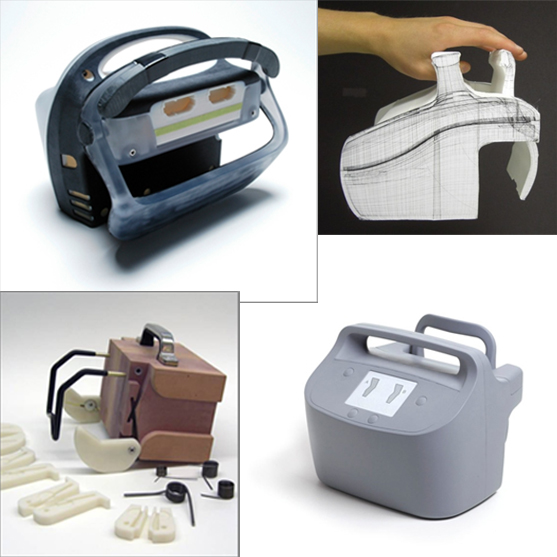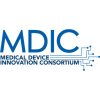Prototyping is a necessary part of any well-executed product development process. Analysis can help build confidence in a design, but often there’s no substitute for a physical model. Models, mockups, and prototypes help industrial designers and engineers get critical feedback on appearance, proportion, fit, function, usability, durability and more. Often, creating a prototype is absolutely necessary to allow software and controls engineers to finish their work.
In an ideal world, production parts could be made at low cost and in very short timeframes, making it easy to build and test the real product. In the real world, time and budget constraints force engineers to build prototypes with materials and processes that are not identical to the final product. This is where engineers have to be creative to maximize the value of their prototypes. Medical device development places some special requirements on prototypes, especially later in the development process.
Ultimately, when developing a medical device, the development team has to prove that they have tested samples of the device that will be put on the market. At some point, devices built with production equivalent parts and processes have to be tested. Especially with molded plastic components, there is a strong motivation to be very confident in the design prior to committing to expensive tooling. But how does an engineer gain that confidence with prototype materials that don’t behave the same or cannot reach the same levels of dimensional tolerance? By being a little creative!
What’s important?
The first key is to really understand what is most important about the part. Need tight tolerances? Look to SLA, machining, or a combination of additive processes and machining processes. Are material properties most important? Match the critical properties to the best additive or casting material or consider machining the part from the final materials. The key is to select materials and processes that are good enough but not better than the final part. Analysis can usually point to the critical areas of the design where strength or fit are most important. In many cases, an engineer just needs to get parts in hand to get a better feel for how they fit and function. A number of lower cost 3D printers using the fused deposition modeling (FDM) process are now available and can produce parts quickly and inexpensively. When these printers are available, parts can sometimes be created in as little as a few hours, saving the design team days of speculation about the function of a design. Here are a few examples to help demonstrate the idea.
Break it down
Let’s first consider the issue of prototyping plastic components. Injection molding is widely used in medical devices because it’s inexpensive in higher volumes, tolerances can be held tightly, a wide variety of surface finishes can be produced, and the different resins available offer a huge range of material properties. It’s often difficult to match all of these features in one prototype. Consider performing secondary processes like machining or painting parts to improve tolerances or appearance. Another option is to build multiple prototypes for different purposes. One version may help test the system function because key features can be machined to meet the necessary tolerances. A second prototype can be built from materials of similar strength to test durability.
Quantity matters
The quantity of prototypes needed can often be a determining factor. Rapid tooling cycles are available for aluminum or soft steel injection molds. At quantities around 150-500 parts, this is often more economical than any additive prototyping process or machining, and offers the added benefit of incorporating final materials and geometry. Even if the tool is scrapped after the prototype run, the added confidence in the design and the lower total prototype cost can justify this option. If the design works well, some molders, parts and processes can be qualified for production, and the tooling can be used to manufacture parts until the production tooling comes on line. Many larger pieces of capital equipment, whether they be robotic systems, cautery units, or an endoscopy system, will never reach production volumes that can justify injection-molded components. These sometimes use either thermoformed or cast urethane parts for housings. Both of these processes have complementary prototype processes that produce parts that are very similar to the production versions, giving a great deal of confidence in the final design.
The metal paradox
Let’s now consider metal components. Machining and sheet metal fabrication are common production processes, and can be readily prototyped. Laser sintered metal parts are also an option, but are available in a limited number of materials. Many medical devices use one of several casting or metal molding processes. The properties of cast metals are rarely identical to those of wrought metals used for machining, and most casting or molding methods have poorer tolerances. This is a classic case where the prototype can be better than the production parts, providing a false sense of security in the design. Alternative casting processes are often available. SLA patterns can be used in investment casting processes for several classes of metals. In aluminum, several gravity-fed casting processes can simulate die cast components with different alloys that tend to be a little weaker than most die cast alloys. There are even processes for investment casting very small parts in aluminum with enough detail and surface finish that they can provide a decent functional simulation of a metal injection molded part, albeit with lower strength.
A different type of composite
Sometimes a single solution is not the best solution. By breaking a component down into pieces and bonding or fastening them together, it is possible to optimize different areas of the design and learn a lot about it. In all prototypes, the key is to understand where the design has risk, which areas need to be tested to reduce that risk, and decide on the best process and material for those sections. This method has risk, because the connections between pieces can be weaker than really intended, and additional stresses can be imparted in places that are not realistic. With all of these ideas, it’s important to remember that testing a prototype made from non-production components is not a substitute for verification testing on production equivalent units, but it can help provide a level of confidence in the design so that tooling expenses can be justified with reduced risk of surprises.
Remember, prototyping is expensive. A fully functional prototype can often cost 5 to 20 times more than a production equivalent. Prototypes for high volume disposables can be even more costly because the economies of scale are so favorable in production. The key justifications are always that the prototype improves the development process and saves the development team a significant amount of time. The cost of engineering time can be far greater than a prototype, and the opportunity cost of being late to market can be even greater. Creative construction and use of prototypes can dramatically shorten development time, saving a lot of money.








